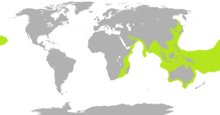Sea snake
| Hydrophiinae | |
|---|---|
 |
|
| Pelamis platura | |
| Scientific classification | |
| Kingdom: | Animalia |
| Phylum: | Chordata |
| Class: | Reptilia |
| Order: | Squamata |
| Suborder: | Serpentes |
| Family: | Elapidae |
| Subfamily: |
Hydrophiinae Smith, 1926 |
 |
|
| range of sea snakes shown in lime green | |
The Hydrophiinae, also known as coral reef snakes or sea snakes, are a subfamily of venomous elapid snakes that inhabit marine environments for most or all of their lives. Most are extensively adapted to a fully aquatic life and are unable to move on land, except for the genus Laticauda, which has limited land movement. They are found in warm coastal waters from the Indian Ocean to the Pacific and are closely related to venomous terrestrial snakes in Australia.
All have paddle-like tails and many have laterally compressed bodies that give them an eel-like appearance. Unlike fish, they do not have gills and must surface regularly to breathe. Along with whales, they are among the most completely aquatic of all air-breathing vertebrates. Among this group are species with some of the most potent venoms of all snakes. Some have gentle dispositions and bite only when provoked, but others are much more aggressive. Currently, 17 genera are described as sea snakes, comprising 62 species.
The majority of adult Hydrophiinae species grow to between 120 and 150 cm (3.9 and 4.9 ft) in length, with the largest, Hydrophis spiralis, reaching a maximum of 3 m (9.8 ft). Their eyes are relatively small with a round pupil and most have nostrils located dorsally. The skulls do not differ significantly from those of terrestrial elapids, although the dentition is relatively primitive with short fangs and (with the exception of Emydocephalus) as many as 18 smaller teeth behind them on the maxilla.
Most Hydrophiinae are completely aquatic and have adapted to their environments in many ways, the most characteristic of which is a paddle-like tail that has improved their swimming ability. To a varying degree, the bodies of many species are laterally compressed, especially in the pelagic species. This has often caused the ventral scales to become reduced in size, even difficult to distinguish from the adjoining scales. Their lack of ventral scales means they have become virtually helpless on land, but as they live out their entire lifecycles at sea, they have no need to leave the water.
...
Wikipedia
